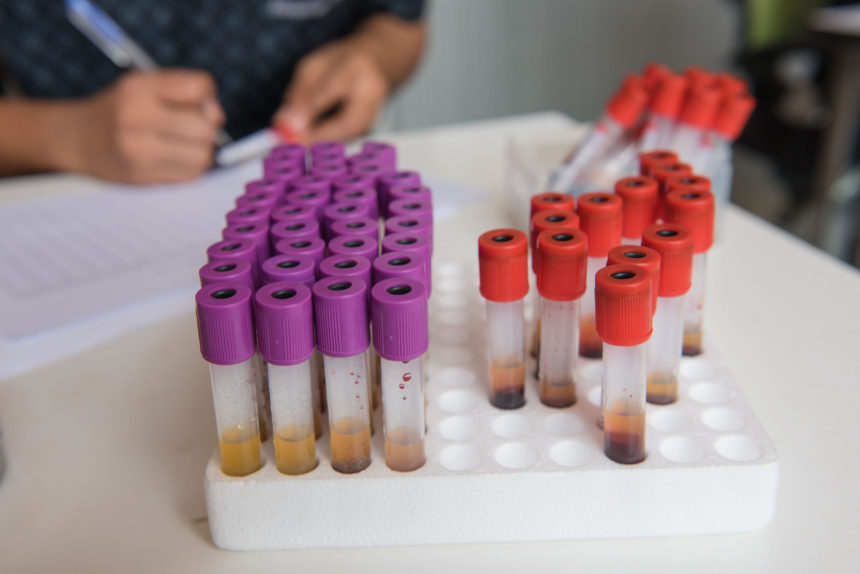This post was originally published on this site
Scientists have developed a simple blood test that may help clinicians identify whether a person has accumulations of abnormal amyloid protein deposits in the brain — an event linked to an Alzheimer’s diagnosis.
This new laboratory test may represent an alternate diagnostic tool to other expensive brain imaging methods currently in use, according to researchers.
The test was described in “High-precision plasma β-amyloid 42/40 predicts current and future brain amyloidosis,” a study published in the journal Neurology.
One of the main features of Alzheimer disease is the accumulation of amyloid plaques in the brain. These plaques are mainly composed of small beta-amyloid protein fragments, often with a length of 42 and 40 amino acids (Aβ42 and Aβ40). Amino acids are the building blocks of proteins.
Assessing these fragments in the cerebral spinal fluid (CSF), which surrounds the brain and spinal cord, is commonly done in the clinic. Still, this approach requires a lumbar puncture procedure — often called a spinal tap — which is an invasive method linked to some risks, and not pleasant for patients.
Another way to evaluate the presence of beta-amyloid plaques is through imaging, such as positron emission tomography (PET) scans. However, this approach also has some cons. It requires exposure to radioactive compounds, is not available in all clinical sites, and is very expensive and may not be covered by insurance.
As such, finding new strategies that can accurately and rapidly help identify beta-amyloid plaques — and diagnose Alzheimer’s disease — with less economic and personal burden is an unmet medical need.
Researchers from Washington University School of Medicine now evaluated the diagnostic potential of this new beta-amyloid blood test. To do so, the team compared the test with standard PET scans or CSF analysis in 158 mostly cognitively normal individuals.
The team analyzed the amount of beta-amyloid fragments — Aβ42 and Aβ40 — in a total of 210 plasma samples from the 158 participants, collected within 18 months of an amyloid PET scan. They also analyzed 186 available CSF samples collected on the same day as the plasma from 145 individuals.
Among all participants, 115 tested negative in PET scans and 43 were found to have beta-amyloid plaques in the brain.
Those who had a negative amyloid PET scan at the beginning of the study had a higher plasma Aβ42/Aβ40 ratio, the results showed. These individuals also had a 15-fold greater risk of conversion to amyloid PET-positive compared with individuals with a negative plasma Aβ42/Aβ40 ratio. The researchers note that the final Aβ42/Aβ40 ratio was obtained by dividing the calculated Aβ42 concentration by the calculated Aβ40 concentration.
This means that plasma Aβ42/Aβ40 values were good predictors of amyloid PET status.
Similar results were obtained with CFS samples, with patients with positive PET scans showing a lower Aβ42/Aβ40 ratio in their CFS.
“Plasma and CSF Aβ42/Aβ40 had concordant predictions for amyloid status in 122 of 145 individuals,” the researchers said.
Older age participants and those who were carriers for the APOE e4 variant — which are known risk factors for Alzheimer’s disease — also had lower Aβ42/Aβ40 ratios.
“Plasma Aβ42/Aβ40, especially when combined with age and APOE e4 status, accurately diagnoses brain amyloidosis and can be used to screen cognitively normal individuals for brain amyloidosis,” the researchers said.
“Plasma Aβ42/Aβ40 could be used in prevention trials to screen for individuals likely to be amyloid PET-positive and at risk for Alzheimer disease dementia,” they added.
More comprehensive studies are currently being conducted to further validate the diagnostic potential of this blood assay. Those studies involve multiple large, international patient groups, including people with symptomatic Alzheimer’s disease.
The results of these additional studies will help assess the clinical utility of this new blood test. That will assist in determining if the test can be accurately used to screen patients for clinical studies and to help advance therapeutic development.
The post New Blood Test May Help Detect Beta-Amyloid Plaques in People at Risk of Alzheimer’s, Study Shows appeared first on Alzheimer’s News Today.
The post New Blood Test May Help Detect Beta-Amyloid Plaques in People at Risk of Alzheimer’s, Study Shows appeared first on BioNewsFeeds.


